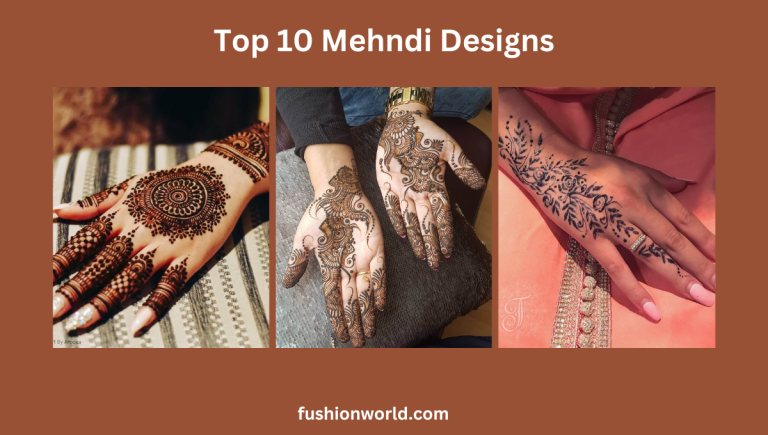Mehndi is the art or the practice of applying temporary henna tattoos. It is a form of temporary decoration using a paste created with henna. However, it is not actually a tattoo as only the surface of the skin is inked, and it does not stay for very long.
It originated in the Middle East and Indian subcontinent, it was a part of the Babylon and ancient Egyptian civilizations. It was common in the fourth century in India, which is evident from the cave art in Ajanta Caves. Mehndi has many variations and designs. Typically applied on occasions such as Hindu weddings and hindu festivals like karva chauth, Vat Purnima, Diwali, Bhai Dooj, Navratri, Durga Puja, Teej, and many more. It is also prevalent to consider applying henna as auspicious in Muslim culture in South Asia; it is applied during their weddings and festivals such as Eid al-Fitr and Eid al-Adha.
Women apply mehndi designs on their hands and feet, imprinting a standard color – Brown. Nowadays, there are mehndi that can be found in many colors, such as white, red, black etc. but the most liked is the traditional color brown.
The process of preparing henna is pretty clumsy. The paste is basically made from the powdered dry leaves of the henna plant(Lawsonia inermis). Here are simple steps for making mehndi paste at home –
- Collect all the ingredients – like henna powder, water, sugar, and lemon juice along with essential oils such as lavender or eucalyptus oil.
- In a bowl, mix the henna powder with the water until a thick paste is formed. The consistency should be near to that of toothpaste.
- Now add sugar to the paste and mix well. Sugar acts as the binding agent, making the paste smooth and preventing it from breaking while being applied.
- Add lemon juice to the paste; it helps to release the dye in the henna powder.
- Add only a few drops of essential oil to the paste and mix well. Essential oil is used to give a pleasant fragrance to the henna, and it also helps to darken the color of the henna. Note: too much essential oil should not be added as it may cause skin irritation.
- Let the paste rest for 6 hours or overnight. Cover the bowl with a plastic wrap and allow the dyes in henna to infuse together.
- Once done, fill the paste in a cone for easy application.
Mehndi is usually applied using a plastic cone. Around half an hour after the application, it starts to dry up and begins to crack. The applied area may be wrapped with a plastic sheet (not tight) or a cloth to lock the body heat to create a more intense color. It can be kept for 1 hour to six hours or sometimes overnight and then removed.
The henna gradually picks the color from dark orange to darker shades of brown; this happens because of oxidation over the course of 24 to 72 hours. The final color can last to around 1 week or so, depending upon the quality of henna and the area of application; the thicker the skin, the darker the color.
There is a great variation in designs of Mehndi; some of its preferred designs are mentioned below –
Circles
The most trendy and elegant of all times, circle mehndi designs are very popular these days. Be it young girls or their mums; all the female clan is keeping them up to date with these trendy designs. The essence of round designs lies in their round shape. It looks classic and is also known as the mandala design. It looks astounding when made with utmost clarity. Intricacy meets aesthetics to deliver a design that is at the top of Mehndi artistry.
Many celebrities like Alia Bhatt and Kiara Atvani have worn round-style designs in their weddings. The circle design will cover almost the front and the back of your hand; it is accompanied by designs made on the fingers radiating a top-class look.
Vine henna
Vine henna design features vines, leaves, and flowers. The design is usually drawn on the palm, it starts from one corner of the wrist and ends at the fingertip on the opposite corner. The vines are the main element of this pattern, and they are drawn in a way that creates a beautiful and intricate design. This design features vines, leaves and flowers to create an intricate pattern.
Arabic design
Arabic Mehndi design is one of the evergreen and popular designs of this art. This style originated in the Middle East and North Africa. It features floral motifs, geometric patterns, and bold strokes. It is not like traditional mehndi, which tends to be complex and densely packed rather, they are generally spaced out creating a free-flowing and elegant look.
Bridal
The bridal mehendi designs are loaded with variations of patterns. It generally extends from the hands to the elbows and sometimes to the upper arm. This kind of design are specially applied to the brides, and there are specialized artists for this. It generally takes around 4 to 5 hours to apply bridal mehndi.
Floral
The floral pattern mainly includes flower and leaf patterns. This design is generally spacious and not densely congested. It looks beautiful and elegant when created properly.
Bail mehndi
Made in the form of a bail, which resembles the stem of a tree that keeps hanging. It starts from one corner of the hand and ends at another. The rest of the hand is empty. It is a light design and takes comparatively less time to make. With little practice, even a nonartist can create this.
Tikki style
This tikki design resembles a round shape filled with henna. It is a very simple and basic design that anyone can make. It hardly takes any time to create. Also, it can be accompanied by a polka dots like pattern.
Net mehndi
This is a simple, easy and best design for backhands. It generally looks beautiful on the backside of the hand. It gives a very royal look to the hands. With this design, there is no requirement for ornaments; this design itself radiates decorative vibes.
Negative spacing
It is the most trending Mehndi design nowadays. It includes making big designs and then filling henna in between them.
Finger Jewellery Mehndi Design
For brides who don’t like applying mehndi, this minimal design is a blessing. This is simple to create, and it gives a jewelry-like feeling to the person.
FAQ’s About Top 10 Mehndi Designs
Ques. What is the most trending Mehndi design?
The most trending mehndi design is Circle mehndi design and negative mehndi design.
Ques. What is so special about bridal mehndi design?
Bridal mehndi holds a special position in the wedding ceremonies. The bridal mehndi usually contains heavy designs in that might depict the various stages of the wedding or things like that.
Ques. Can we make henna paste at home?
Yes, henna paste can be made at home, and the steps of the same are mentioned above in the article.
Ques. How can I suppress the pungent smell of the henna?
For some people, henna does not smell pungent, but for some, it does. To reduce the smell of henna essential oils can be used like eucalyptus oil or lavender oil.
Conclusion
Here are some designs which are in trend these days. Few of them are even worn by the celebrities in their wedding.

